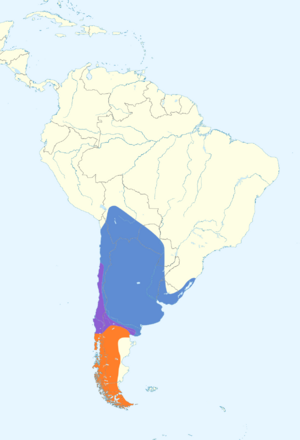Chilean swallow facts for kids
Quick facts for kids Chilean swallow |
|
|---|---|
 |
|
| Conservation status | |
| Scientific classification | |
| Genus: |
Tachycineta
|
| Species: |
leucopyga
|
 |
|
| Synonyms | |
|
|
The Chilean swallow (Tachycineta leucopyga) is a small, fast-flying bird. It belongs to the Hirundinidae family, which includes all swallows and martins. This bird lives in Chile and Patagonia. It also travels north to places like Bolivia and Paraguay.
Contents
About the Chilean Swallow
What's in a Name?
The name Tachycineta comes from Ancient Greek. It means "moving quickly," which perfectly describes these speedy birds. The species name leucopyga refers to its white rump.
How to Spot One
The Chilean swallow is about 13 centimetres (5.1 in) long. It weighs between 15–20 grams (0.53–0.71 oz), which is very light! Its back is a shiny blue-black color. Its belly is white, and it has a clear white patch on its rump.
Its wings and tail are black. The inner parts of its wing feathers have white tips. Both its beak and legs are black. Male and female Chilean swallows look alike. Young birds are a bit duller and browner.
This swallow looks a lot like the white-rumped swallow. However, the Chilean swallow does not have a white forehead. Its upper parts are also bluer.
Where Do They Live?
This swallow lives in several South American countries. You can find it in Argentina, Bolivia, Brazil, and Chile. It also lives in the Falkland Islands, Paraguay, and Uruguay. Sometimes, it visits South Georgia and the South Sandwich Islands.
Chilean swallows breed from the Atacama Desert in Chile. Their breeding range extends across most of Argentina. It goes all the way to the southern tip of South America. Birds in the northern areas stay there all year. Those in the south migrate to warmer places for winter. They often spend winter in northern Argentina, southern Brazil, or Uruguay.
Life and Habits
Nesting and Young
Chilean swallows build their nests in natural holes. They also use cavities made by people. They usually build nests near water. These birds often nest alone. Sometimes, they form small groups if there are many good nesting spots close by.
Their nests are made of mud or dry grass. They line the nests with soft feathers. The breeding season usually starts in September or October. It lasts until February. In Chile, a pair might raise two or three groups of young birds each year.
A female Chilean swallow usually lays four to six white eggs. Each egg is about 17.8 mm–21 mm × 13 mm–14.3 mm (0.70 in–0.83 in × 0.51 in–0.56 in) big. They weigh around 2 g (0.071 oz). After the breeding season, these swallows often gather in large flocks.
What They Eat
Chilean swallows are insectivores. This means they mostly eat insects. They especially like flying insects. They usually hunt for food alone or in small groups. When they fly to catch insects, they fly low and straight.
Conservation Status
The Chilean swallow is considered a least concern species. This is according to the IUCN. This means the species is not currently at risk of disappearing. The population is growing, and they have a very large habitat.
Images for kids




